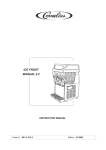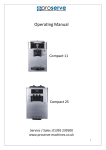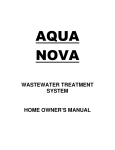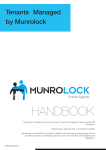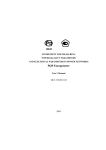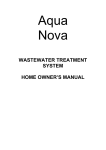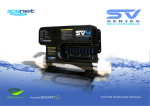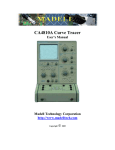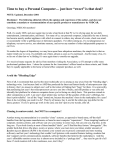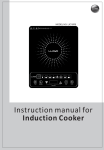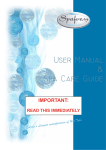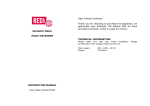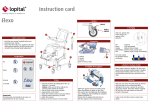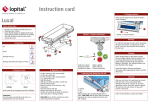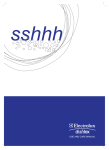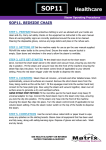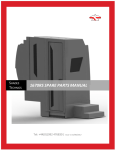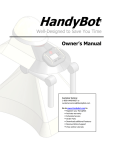Download CLEAN FOOD PRODUCTION AREAS
Transcript
CLEAN FOOD PRODUCTION AREAS Why cleaning is important • In any business the soiling of surfaces and equipment by food scraps, grease or other mess is unavoidable. This soiling is potentially dangerous! • It is essential that all wastes, dust, dirt, stains and grease are not allowed to build up. • Cleaning is the process of removing soil from all surfaces, fixtures, utensils and equipment, but it doesn’t stop in the kitchen. Other areas such as rubbish containers and storage areas need constant cleaning. • Surfaces you will be required to know how to clean may include: • metal • wall tiles • painted • glass • floor tiles or vinyl or linoleum floor coverings • laminated surfaces. • Cleaning should always be seen as a preventative measure not as an after thought! Activity Tip List your restaurant’s cleaning schedule below. E.g. Mondays = walls, Tuesdays = extractor, daily = floors etc. Monday Tuesday Wednesday Thursday Friday Saturday Sunday The following flow chart demonstrates why cleaning is important and the areas it can affect if it is not done properly. CUSTOMER SATISFACTION A clean, attractive environment for customers and staff promotes a favourable image and helps to make Debonairs Pizza successful. PREVENT FOOD POISONING Your customers expect good quality food. Dirty equipment and work surfaces can be a breeding ground for bacteria and can increase the risk of food poisoning. Careless kitchen practices can cause food spoilage. Customers will not be impressed if they find fragments of glass or other foreign objects in their meal. PREVENT DISEASE SPREADING Dirt and food scraps that build up may attract mice, cockroaches, flies and other pests – leave nothing to chance. SAFE WORKING CONDITIONS Spillages are inevitable, but if left they can cause a build up of dangerous greasy surfaces. The use of protective gloves and clothing when handling cleaning chemicals is very important. COST EFFICIENCY Always keep equipment clean and in good working order. Replacements are never cheap. Clean Food Production Areas -2- Developed 20/04/2007 Cleaning equipment It is important to remember when using a range of cleaning products that you must always follow the manufacturer’s requirements. Most products will specify the amount to be used and the protective clothing necessary to perform the task. This will reduce the risk of accidents and cut down on costs due to excess use. Separate cleaning equipment should be used to perform different tasks. For example, if you were cleaning a bench top with a cloth, then you would not use the same cloth to wipe up a spill on the floor. Cross contamination, or the transferring of dirt and bacteria from one surface to another, will greatly increase the chance of food poisoning. Brooms, Dust Pan and Brush These are used to remove visible dry spillages, dust, dirt, scraps and breakages. Mop and Bucket These are used when cleaning floors with detergents and sanitisers. They can also be used to wipe up wet spills. Detergents Detergents are mixed with the correct amount of water and used to remove grease, stains, marks or other soiling from surfaces. These chemicals are designed to do a single job and do not kill bacteria. Sanitisers - Bactorex These are used after detergents to reduce bacteria to low and acceptable levels. Very hot water can be used as a sanitiser because water heated above 75 degrees will kill bacteria. Sanitisers should never be dissolved in hot water as it reduces the effectiveness of the sanitiser Disinfectants These are chemicals designed for specific use in different areas. Different disinfectants have been designed to meet the needs of different areas and should never be used elsewhere. Disinfectants are designed to kill specific types of bacteria and are usually perfumed. Detergents come in different forms and can be used to clean specific surfaces. Listed below are some examples. Soap The simplest form of detergent, generally not suitable for kitchen use as it can leave residues. Alkaline Detergents These remove dirt and grease and hold it suspended in the water, this helps in effective rinsing. Quite commonly found in dishwashing systems. Acidic Cleaners These can remove tarnish on metals and are often used to remove “scale” in hot water urns and dishwashers. Abrasive Cleaners These can be used to help remove baked on foods and stubborn stains. Clean Food Production Areas -4- Developed 20/04/2007 Important points to be observed! When using equipment to perform a cleaning task you should consider the surface to be cleaned. Some surfaces can mark and scratch easily so select the right tool for the job. Other surfaces may require heavy-duty sponge scourer / scourer pads and brushes. To achieve the best results with detergents consider the following factors. • The right choice of a detergent for each particular cleaning job. • The type and amount of dirt involved. • The temperature at which the detergent is most effective. • The concentration of detergent required. • The time required for the detergent to take full effect. Steps in cleaning process There are five basic steps for any cleaning to be effective. They apply to all types of food establishments and include the cleaning of equipment, utensils, crockery, cutlery, floors and walls. Pre cleaning Remove food scraps dirt and grease by soaking, scraping, rinsing and sweeping. Main cleaning Remove surface dirt, food debris, marks or grease by washing and scrubbing using a detergent. Sanitising Use a chemical sanitiser or very hot water to rinse or soak. Air-drying Allow items to air-dry naturally on a clean, dry sanitised surface. The use of tea towels can lead to further marking and cross contamination. Clean Food Production Areas -5- Developed 20/04/2007 Post cleaning Make sure all sinks are thoroughly rinsed out and that the drainage is free of waste and blockages. Rinse and hang mops and cloths to air dry them Rinse buckets and hang them upside down, this will help to prevent rusting and allow for quicker drying. Cleaning sinks and hand basins • Whether you are using a sink or hand basin for cleaning purposes or food preparation, it is important to make sure it is kept clean and free from blockages at all times. The most effective way to clean a sink is to use a multi-purpose cleaner and a clean cloth or sponge scourer / scourer pads. Cleaning products that contain both a detergent and a disinfectant enable you to do the cleaning in one step. • Remove all marks, food debris or food particles and dispose of them immediately. • Make sure the plugholes are free of debris and the sink is draining effectively by flushing running water through it. Leftover food particles will dry and block the sink and may even attract unwanted pests. Activity Tip Find out what method is used in your organisation for un-blocking drains. Clean Food Production Areas -6- Developed 20/04/2007 Cleaning work surfaces, walls and floors • All surfaces need to be cleaned after every service. It is recommended that you clean as you work to save on overall cleaning time when you finish. • When cleaning work surfaces, walls and floors it is very important to make sure you use a cloth or mop that will not damage the surface you are cleaning. Some scourers such as wire wool can scratch delicate surfaces and these scratches can build up with food scraps and promote the growth of bacteria. • Sweep and wipe down all areas to clear away all food particles and debris before mopping or washing. Check underneath all benches and equipment. Work Surfaces and Walls It is best to use the “Two Bucket Method” when cleaning work surfaces and walls that are metal, tiled, painted, glass and vinyl. The Two Bucket Method 1. Gather two different coloured buckets, e.g. red and blue. 2. Use a clean cloth in each bucket. 3. Fill the red bucket with a multi-purpose cleaner and warm water. (Follow manufacturer’s instructions.) 4. Fill the blue bucket with hot water. 5. Dip a clean cloth into the red bucket and clean the surface or wall. 6. Allow the liquid to stand on the surface for 5 minutes to give the disinfectant time to work. 7. Using a clean cloth from the blue bucket, wipe and rinse down the surface. 8. Rinse out the cloth and sponge dry the surface (use paper towelling to dry windows, this will help to prevent marks). Floors Tiled, linoleum, or painted concrete floors can be cleaned using the following procedure. Remember to always post warning signs or cordon off the area before you begin mopping. • Fill the mop bucket with hot soapy water 50° – 60°C. • Soak a clean mop in soapy water until it is wet all the way through. Ring the mop out using the ringing well on the bucket until most of the water is removed. (Do not use hands as there may be glass or other sharp objects tangled in the mop). Clean Food Production Areas -7- Developed 20/04/2007 • Start mopping, cleaning an area no bigger than 2 square metres at a time until the designated area is clean and all removable marks and stains have gone. If this has not been achieved, repeat the process until the whole area is clean. • Allow the area to air dry. Cleaning drains, gully traps and overflows Regularly clean drains, gully traps and overflows as these areas breed bacteria and disease. Pests such as flies, cockroaches, rats and mice live and breed in these warm, moist and dark spaces, so always remember to: • use commercial/industrial grade cleaners or degreasers • follow manufacturer’s directions and pour the quantity required into the drains, gully traps and overflows • allow to stand for the recommended length of time, according to manufacturer’s directions • flush thoroughly with boiling water as this will help to remove any blockages Cleaning shelving, cupboards and drawers When cleaning in the kitchen, shelving, cupboards and drawers are often forgotten. Food can be spilt on or in these places and this can attract unwanted pests and vermin. The incorrect storage of knives and equipment in drawers, shelves and cupboards can also be risky. Follow the procedures below. • Clear shelves, drawers and cupboards of all stored materials and equipment. • Using a dry cloth or brush, dust the area to remove dirt and food particles. • Wash the area with hot water and detergent using a cloth to wipe down all areas thoroughly. • Sanitise and rinse down all equipment storage areas. • Allow areas to air dry. Clean Food Production Areas -8- Developed 20/04/2007 • Replace all material and equipment in an organised and neat fashion. • Observe use by dates and stock rotation procedures when returning food products back to shelving and cupboards. Clean Food Production Areas -9- Developed 20/04/2007 Storing cleaning equipment and materials It is very important that equipment and potentially hazardous supplies and chemicals are stored in a safe way to prevent accidents, contamination and/or injury to staff. It is important to make sure that cleaning products are stored separately to all other items, kept under strict security and monitored for use. A well-planned storage area will improve efficiency in daily work routines, stock take, inventory control and ordering, maintenance and safety. Types of Cleaning Equipment and Materials This equipment and cleaning products require storage in the one area. mops buckets brooms detergents sanitisers disinfectants oven cleaners bleach abrasive cleaners sponge scourer / scourer pads cloths sponges gloves hand cleaners paper towelling soaps polish carpet shampoos laundry powder dishwashing liquids Rules for Storage • All cleaning equipment should be sanitised, rinsed and hung up to air dry. • Storage areas should be well ventilated and have good lighting. • Make sure all cleaning chemicals are properly labelled and stored away from other products. • Never store cleaning chemicals in old drink bottles because they could be mistaken for a drink. • Make sure chemical dispensers with taps have drip trays in place, to stop any accidents from occurring. • Colour code different containers of diluted chemicals to avoid confusion. • Never allow rubbish to build up in storage areas. • Do not store anything at ground level, place it on a shelf or hang it up. • Shelves and floors should be cleaned regularly. • Use a ladder when reaching up to high shelving to avoid the risk of spilling chemicals on yourself. • Make sure every item has a regular place of storage. Disposal of refuse and food waste Garbage is a by-product of all food service operations. Crew needs to be made aware of all garbage containers and areas of disposal. Crew also needs to know the organisational requirements for recycling procedures. Garbage is a potential source of cross contamination for both food handlers and pests. The food handler who comes into contact with garbage and then touches food can pass on harmful bacteria to a customer. Pests that breed, live and feed on garbage can also land on surfaces where food is prepared. The basic rules for garbage disposal are as follows. • Remove all leftover food, vegetable and meat scraps from the work place and put them in lined bins. • Wash your hands immediately after handling garbage or garbage containers. • Line all garbage bins with plastic liners and replace them as needed. • Clean garbage containers frequently with hot soapy water and disinfectant to remove all food residues. Dry immediately. • Cleaning equipment that is used for cleaning bins and refuse containers should not be used to clean other areas or surfaces. • Provide lids for bins and make sure they are closed at all times to stop from pests from getting in and bad odours from getting out. • Make sure garbage containers are adequate in size and number to avoid overflow and spillage. Working in an organised and efficient way Every Debonairs Pizza will have certain procedures or requirements in place. These procedures are based on current national laws for Food Hygiene, Occupational Health and Safety rules and Employee Relations. They will also have procedures to suit their style of business. These may include customer relations, cleaning schedules and dress codes. It is important to note the following points to improve efficiency in the workplace. Clean Food Production Areas - 11 - Developed 20/04/2007 • Working efficiently will reduce the amount of take it takes to do a task. • Always try to minimise disruption to you and other staff members. • Prepare a work plan listing the tasks that need to be done and the approximate time needed. • Collect all equipment before starting a task. • Explain to fellow crew the tasks that need to be completed and make sure everyone understands their role. • Do not undertake cleaning procedures when food service is in progress. • Use labels and signs in the work area so equipment and materials can be returned to the correct place when they are not being used. Cleaning food production equipment Great care should be taken when operating or dismantling food production equipment. If using any piece of electrical or gas equipment for the first time you should seek help from your supervisor or refer to the equipment’s user manual. Dismantling and Cleaning Electrical Equipment • Turn off the power and unplug the cord from the power point (liquids conduct electricity and together they are dangerous). • Dismantle equipment according to manufacturer’s instructions. • You may wash parts of the equipment that do not contain any electrical wiring or machinery with a dry or partially damp cloth. Do not use excessive water as this can damage electrics and be extremely dangerous once turned on. • Make sure all parts are dry before reassembly and that the storage place for equipment is clear of debris and spills. Clean Food Production Areas - 12 - Developed 20/04/2007 Dismantling and Cleaning Gas Equipment • Turn off and disconnect gas supply. • Allow ample time for equipment to cool down after use. • Follow manufacturer’s specific instructions when dismantling. • Remove parts that are designed to be taken out for easier cleaning, e.g. drip trays, racks, pot stands. • Clean equipment using item-specific cleaning agent, e.g. cleaners for aluminium, cast iron and stainless steel. • Rinse and flush out any food particles or debris using water pressure, this will prevent blockages in gas jets and burners. • Dry all parts thoroughly checking that no water remains and reassemble equipment. Clean Food Production Areas - 13 - Developed 20/04/2007 List all of the cleaning chemicals used in your organisation and explain their use. Exercise Chemical Use Listed below are the basic cleaning procedures for a range of different kitchen equipment including: • ovens • fryers • makeline and bain-marie • dough mixer. Ovens and Racks • Warm the oven, this will make cleaning easier. • Spray with oven cleaner and allow standing for the time required by the manufacturer’s instructions. • Wear gloves and safety glasses when using heavy-duty cleaning agents, this will help to prevent contact with skin. Clean Food Production Areas - 14 - Developed 20/04/2007 • Wear a facemask and turn on exhaust fan to prevent breathing in fumes. • Wipe and rinse down areas where oven cleaners have been used with cold water. Dough Mixer Turn off and dismantle the mixer, taking care to remove the plug from the wall socket. • Remove attachment beaters carefully. • Wipe off any food scraps or debris. • Wash the body of the machine and the attachments with hot detergent and water. Do not allow water to enter the motor compartment. This could cause electric shock or damage the motor once turned on. • Use a dry cloth to dry the body of the machine. • Rinse the attachments and allow them to dry. Deep Fat Fryer • Turn off the fryer at the wall power point or gas supply. If electric, remove plug from socket. • Place a drum under the fryer, open the drainage plug and allow all the liquid to drain. • Replace the drainage plug. • Wearing gloves, spray degreaser inside the fryer and allow it to stand for 10 minutes. • Wipe down the inside of the deep fryer with a scouring sponge, hot water and detergent. • Place a second container under the fryer and open the drainage plug to allow the water to pour out. • Rinse the inside of the fryer thoroughly, drain and allow to air dry. • Use a sponge scourer, hot water and detergent to wash the outside Clean Food Production Areas - 15 - Developed 20/04/2007 of the deep fryer and frying baskets. • Rinse with cold water and allow drying. • Replace drainage plug and refill with oil once completely dry. • Special care must be taken to make sure all water is removed to prevent accidents (fire, explosions, etc). Makeline and Bain Marie • Turn off power at the main switch or gas supply. • Wipe the outside of the unit with a damp cloth to remove all leftover food. • Remove all of the insert containers. • Wash all inserts with hot water and detergent. • Rinse them and allow them to dry. • Use hot water, detergent and sponge scourer / scourer pads to wash inside of the unit. • Rinse the inside of the unit with cold water and drain. • Allow to air dry before using. Handling and storing food production equipment Time management is essential. Much time can be wasted when trying to locate equipment and utensils that have not been returned to allocated storage areas. Safety in the work place is also a major concern when handling utensils and equipment. It is vital that hospitality workers become aware of particular work place hazards and the ways to minimise the risk for both themselves and fellow employees. It is important to store equipment and utensils in allocated storage areas, i.e. chopping boards back in racks, spoons and spatulas on hooks and knives in sheaths • never to place any sharp object in the sink, i.e. knives, blades and tin openers. Always wash separately. Clean Food Production Areas - 16 - Developed 20/04/2007 • All equipment should be thoroughly cleaned, dried and stored after use to prevent build up of bacteria that can cause food-related illness. A major cause of food poisoning and food contamination is the result of improper storage and handling of utensils and equipment. Dealing with unexpected situations Observing and following standard procedures is the best way to prevent the unexpected happening. However, these situations do arise and they should be reported to your supervisor in accordance with organisational requirements. Trained hospitality staff can save lives. A First Aid Certificate is a real asset because you are better able to deal with the unexpected injury. The most common types of hospitality workplace accidents Cuts and Abrasions: Falls: Burns and Scalds: Strains and Sprains: Machine Injuries: Chemical Injuries: Clean Food Production Areas - mostly from kitchen knives - broken glass - can lids - sharp edges of equipment. - slipping on spillages - bumping into other people - tripping over items. - steam - gas flames - hot oil - hot pans. - incorrect handling or lifting - slips and falls. - electric shock - fingers/clothing caught in machinery. - ingestion of poisonous chemicals - spillage of corrosive chemicals on person. - 17 - Developed 20/04/2007 Self Assessment Instructions • In the following test you will be required to answer all questions. • You are required to obtain 100% to pass. • If you do not obtain the pass mark, revise all the learning material and redo the test. Question 1 Why should warning signs be displayed when cleaning floors? Question 2 Why is it important to use the correct chemicals when cleaning? Question 3 Why should cleaning materials be stored separately from food? Question 4 Why should manufacturer’s instructions be followed when dismantling and cleaning machines? Question 5 Explain the following phrase: “Clean as you go, and you won’t have to go and clean!” Clean Food Production Areas - 18 - Developed 20/04/2007 Practical Exercise Practical Exercise Task No. 1 Task No. 2 Task No. 3 Task No. 4 Task Type Date Completed Comments by Supervisor Demonstrate the dismantling, cleaning and re-assembly of a machine to your supervisor. Demonstrate the dismantling, cleaning and re-assembling of the oven, to your supervisor. Demonstrate the 2-bucket cleaning system. Demonstrate how to clean the dough mixer Clean Food Production Areas - 19 - Developed 20/04/2007



















